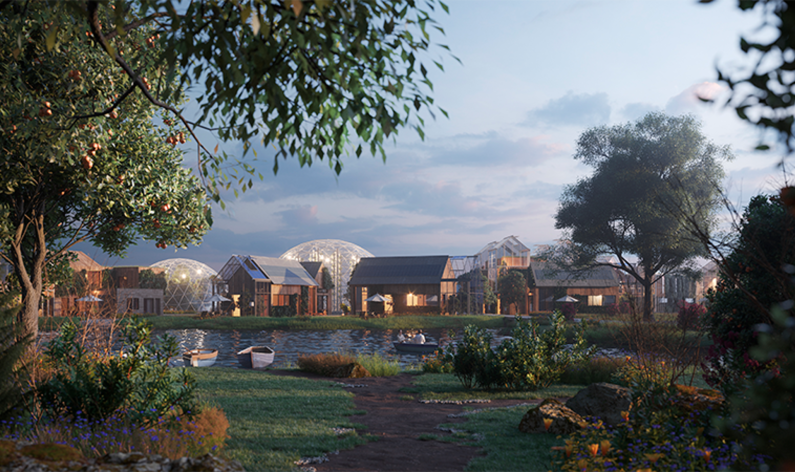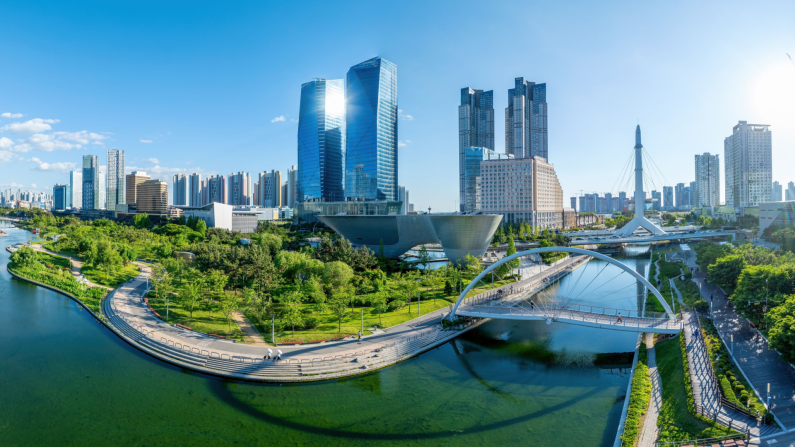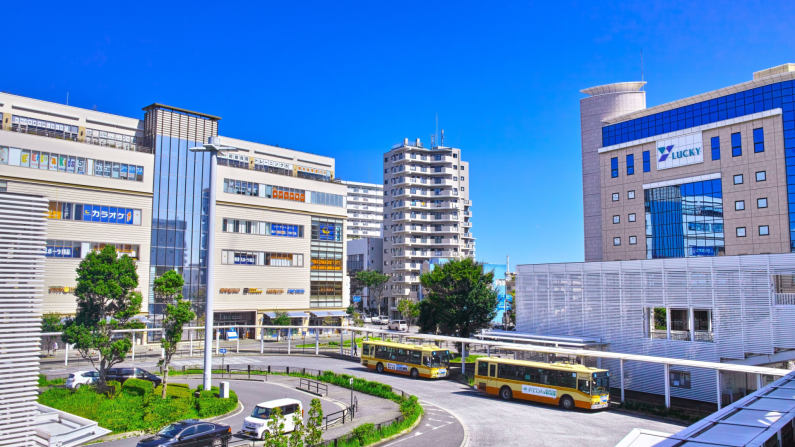When we say the phrase “village of the future,” our imagination involuntarily conjures up futuristic landscapes from science fiction films like “The Island” or “Blade Runner.”
Robotic cows, electric flowers, and neon farms. Fortunately or unfortunately, the villages of the future look different in reality, but they already exist! Unique settlements are actively emerging around the world where traditional rural life is organically intertwined with advanced technologies — from modular construction to artificial intelligence managing local ecosystems.
These high-tech villages are not just demonstration sites for innovation, but fully functional communities where real people live and work. They have become innovators and ambassadors of solutions that can finally solve global problems such as the overpopulation of megacities due to urbanization and even resource scarcity. In this article, we will tell you about five such villages and small towns where daily life is entirely based on what previously seemed possible only somewhere in Silicon Valley - and all around there are still green meadows and pastures!
ReGen Villages (Netherlands): When a Village Turns into a Generation Z Dream

Located 30 kilometers from Amsterdam, in the city of Almere, one of the most ambitious sustainable living projects, “ReGen Villages,” is being implemented, which The New York Times wrote about back in 2016. This super-innovative village, whose first houses finally began to be occupied in 2024, represents a closed ecological system where practically nothing is wasted.
The concept of ReGen Villages was developed as a response to three global challenges of our time: the depletion of natural resources, climate change, and growing urbanization. The founders of the project set themselves an ambitious goal — to create a settlement that not only minimizes harm to the environment but also actively contributes to its restoration. Hence the name - “regenerative village.” To justify it, the village’s energy system is a complex hybrid of solar panels, wind generators, and biogas plants that fully cover the needs of residents. Particular attention is paid to food production: advanced methods of aquaponics (joint cultivation of fish and plants) and vertical farming are used here, which allows harvesting year-round without the use of pesticides.
The waste processing system in ReGen Villages also deserves special attention. All organic waste is converted into fertilizers through the process of anaerobic digestion, and water undergoes multi-stage treatment and is reused. Houses are built from eco-friendly modular materials using elements of 3D printing, although a complete transition to 3D in all aspects was planned (it turned out that this is currently technically impossible due to scaling barriers, but someday…).
Life in ReGen Villages is a constant experiment. Residents are recruited from among volunteers, and the first residents were mainly families with children leading a healthy and ecological lifestyle. Their homes are equipped with smart sensors that automatically adjust lighting, heating, and water consumption, optimizing energy consumption. Imagine if you build many, many such villages or introduce their habits and technologies into megacities? That’s paradise on Earth!
Songdo (South Korea): A Smart City with Elements of Rural Life

Songdo is not a village, but we could not help but mention it, as it is the standard of the very “settlement of the future” - intimate, “green” and high-tech. Songdo is located on the artificial island of Yeongjong, half an hour’s drive from Seoul. Although formally considered part of it, that is, part of the metropolis, Songdo is a distinctive and almost independent ecosystem.
Thus, the main feature of Songdo is the total digitalization of all aspects of life. Smart infrastructure here begins literally from the doorstep: sensors built into sidewalks and buildings continuously monitor air purity, noise levels, traffic flow, and energy consumption. The system analyzes this data in real-time, automatically optimizing the operation of urban services. For example, when sensors record an increase in pedestrian flow in a certain area, additional robot cleaners are sent there.
Songdo’s transport system is also a model of efficiency and environmental friendliness. The main emphasis is placed on bicycle paths and public transport in the form of unmanned electric buses, forming an extensive network throughout the island. Personal cars are not prohibited here, but the infrastructure is deliberately designed to make their use inconvenient, so most residents simply do not use them.
Instead of traditional garbage cans, Songdo has intelligent sorting stations that automatically separate waste into 40 different categories using computer vision and artificial intelligence, thereby freeing residents from the need to do it manually (and minimizing distribution errors). An underground pneumatic system transports waste directly to processing plants, eliminating the need for garbage trucks. Can you imagine life without that terrifying noise at 6 am under the windows? Oh yes, a dream!
In general, all life in Songdo is organized according to the principle of a “15-minute city” — everything you need (work, shops, schools, parks) is within a short walking or cycling distance, thanks to which the city really resembles a small village where everything you need is at hand. However, it also has disadvantages: at the moment, the development of the city has been suspended, since Koreans are not very attracted to this format of living, in addition, housing in Songdo is very expensive.
Fujisawa (Japan): A Settlement That Can Survive Even in the Apocalypse

The small town of Fujisawa, located in Kanagawa Prefecture, is located just 50 kilometers from Tokyo, but is a “living laboratory” where they are experimenting with the concept of sustainable development and “smart” life. This settlement grew up on the site of a former Panasonic television factory, which proves that even an industrial wasteland can be turned into a thriving and environmentally friendly oasis.
Thus, the history of Fujisawa as an eco-city began in 2011 when, as a result of the closure of the factory, a huge territory was abandoned. Fortunately, the company did not leave it to its fate, but developed an ambitious plan to create a sustainable settlement that would become a model for other cities of the future. This is how Fujisawa Sustainable Smart Town (FSST) — “Sustainable Smart City Fujisawa” appeared.
The main goal of FSST is to reduce the impact on the environment and at the same time create a comfortable environment for life. To do this, the city uses the most advanced technologies. For example, energy supply is provided by solar panels placed on the roofs of small cottages, which reduces carbon dioxide emissions by 70% compared to an ordinary city. Smart networks also control energy consumption, optimizing its distribution and reducing losses.
In Fujisawa, great attention is paid to water resources management. Rainwater is collected and used to irrigate green spaces and flush toilets. Smart sensors monitor the condition of water supply networks, preventing leaks and accidents. From a transport point of view, electric cars and bicycles are actively used in the city. Public transport is optimized using intelligent traffic management systems. Among other things, car sharing and bicycle services are available for FSST residents.
Although the Fujisawa ecosystem cannot yet be called completely independent and indestructible, in the event of an accident that de-energizes Tokyo and the entire region, Fujisawa will be able to hold out and function normally for at least three days. Such settlements are extremely important for Japan, which regularly suffers from typhoons and earthquakes. Thus, Fujisawa is another achievement in the field of adaptation to natural disasters. At the same time, the city, of course, has shops, restaurants, schools, medical facilities, and community centers. All infrastructure facilities are located within walking distance, which allows residents to save time and energy. And you can not forget about video surveillance and alert systems, guaranteeing security!
As you can see, today such settlements are still in the stage of their formation and development, and there are not so many of them. Many of these projects are still local in nature and have not received widespread distribution and popularity due to the cost of implementation and the high cost of participation. But the fact that a start has been made is a fact that cannot but rejoice.
Share this with your friends!





Be the first to comment
Please log in to comment